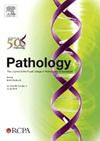Genotypic diversity and antimicrobial resistance phenotype of carbapenem-resistant and carbapenem-susceptible Acinetobacter species isolates
IF 3
3区 医学
Q1 PATHOLOGY
引用次数: 0
Abstract
Members of the Acinetobacter baumannii complex are common nosocomial pathogens with propensity for developing carbapenem resistance. Much emphasis is placed on carbapenem-resistant Acinetobacter baumannii (CRAB), although carbapenem-susceptible Acinetobacter baumannii (CSAB) isolates also cause serious infections. Genomic and phenotypic differences between these isolates are analysed in this study. Whole-genome sequencing was performed on a collection of 90 non-duplicate isolates of Acinetobacter spp. isolates. Phenotypic susceptibility results performed routinely were also collected and correlated against presence of antimicrobial resistance (AMR) genes. The included isolates were predominantly A. baumannii (n=77), followed by Acinetobacter nosocomialis (n=8), Acinetobacter pittii (n=2), Acinetobacter ursingii (n=1), Acinetobacter soli (n=1), and Acinetobacter colistiniresistens (n=1). After excluding duplicate isolates, most of the 77 A. baumannii isolates were identified as carbapenem-resistant sequence type (ST) 2 strains (n=43), which were associated with the presence of oxacillinase (OXA)-23 carbapenemases. Comparatively, CSAB were more diverse, comprising various STs. Overall susceptibilities to non-β-lactam antibiotics indicate highest susceptibility rates to co-trimoxazole, followed by gentamicin and quinolones. Isolates that were resistant to co-trimoxazole possessed sul1 and/or sul2 genes and isolates resistant to gentamicin had armA and/or ant(2″)-Ia genes. CRAB and CSAB were also distinctly different in terms of resistance to non-β-lactam antibiotics with >90% susceptibility to quinolones, co-trimoxazole, and gentamicin in CSAB isolates, compared to 4.2%, 56.3%, and 33.3% in CRAB. Further stratification was performed based on capsular polysaccharide [K locus (KL)] types. The resistance rates amongst the three most common KL types in carbapenem-resistant ST2 isolates showed considerable variation. For gentamicin, 92.9% (13/14) of KL10, 61.5% (8/13) of KL210, and 45.5% (5/11) of KL2 isolates were resistant. For co-trimoxazole, 0.0% (0/14) of KL10, 92.3% (12/13) of KL210, and 36.4% (4/11) of KL2 isolates were resistant. Overall, the most common types were KL10 (n=15), KL210 (n=14), KL2 (n=11), KL24 (n=6), and KL106 (n=5). The most common types seen in blood isolates were KL210 and KL24 (n=4 each). In summary, CRAB in our institution is dominated by ST2 isolates. There was also strong correlation between the AMR genes present with phenotypic resistance in our collection of isolates. KL type provides further stratification of isolates in terms of invasiveness and AMR.
碳青霉烯耐药和碳青霉烯敏感不动杆菌的基因型多样性和耐药表型。
鲍曼不动杆菌复合体的成员是常见的医院病原体,具有发展碳青霉烯类耐药性的倾向。尽管对碳青霉烯敏感的鲍曼不动杆菌(CSAB)分离株也会引起严重感染,但对碳青霉烯耐药的鲍曼不动杆菌(CRAB)仍有很大的关注。本研究分析了这些分离株之间的基因组和表型差异。对收集的90株不动杆菌非重复分离株进行全基因组测序。还收集了常规的表型敏感性结果,并将其与抗菌素耐药性(AMR)基因的存在相关联。纳入的分离株以鲍曼不动杆菌(77株)为主,其次为医院不动杆菌(8株)、皮不动杆菌(2株)、奶源不动杆菌(1株)、固体不动杆菌(1株)和耐粘菌不动杆菌(1株)。排除重复的隔离之后,大部分的77 a . baumannii隔离被确定为特序列类型(ST) 2株(n = 43),都与oxacillinase的存在(OXA) -23 "。相比之下,CSAB更为多样化,由各种STs组成。对非β-内酰胺类抗生素的总体敏感性表明,对复方新诺明的敏感性最高,其次是庆大霉素和喹诺酮类药物。对复方新诺明耐药的分离株具有sul1和/或sul2基因,对庆大霉素耐药的分离株具有armA和/或ant(2″)-Ia基因。螃蟹和CSAB对非β-内酰胺类抗生素的耐药性也有明显差异,CSAB菌株对喹诺酮类、复方新诺明和庆大霉素的敏感性为4.2%、56.3%和33.3%,而CSAB菌株对喹诺酮类、复方新诺明和庆大霉素的敏感性为4.0%。根据荚膜多糖[K位点(KL)]类型进行进一步分层。耐碳青霉烯ST2菌株中三种最常见KL类型的耐药率差异较大。对庆大霉素耐药的KL10、KL210和KL2分别为92.9%(13/14)、61.5%(8/13)和45.5%(5/11)。对复方新诺明的耐药菌株KL10为0.0% (0/14),KL210为92.3% (12/13),KL2为36.4%(4/11)。总的来说,最常见的类型是KL10 (n=15), KL210 (n=14), KL2 (n=11), KL24 (n=6)和KL106 (n=5)。血分离株中最常见的类型是KL210和KL24 (n=4)。综上所述,我们机构的CRAB以ST2菌株为主。在我们收集的分离株中,AMR基因与表型抗性之间也存在很强的相关性。KL型在侵袭性和抗菌素耐药性方面提供了进一步的分离株分层。
本文章由计算机程序翻译,如有差异,请以英文原文为准。
求助全文
约1分钟内获得全文
求助全文
来源期刊

Pathology
医学-病理学
CiteScore
6.50
自引率
2.20%
发文量
459
审稿时长
54 days
期刊介绍:
Published by Elsevier from 2016
Pathology is the official journal of the Royal College of Pathologists of Australasia (RCPA). It is committed to publishing peer-reviewed, original articles related to the science of pathology in its broadest sense, including anatomical pathology, chemical pathology and biochemistry, cytopathology, experimental pathology, forensic pathology and morbid anatomy, genetics, haematology, immunology and immunopathology, microbiology and molecular pathology.
 求助内容:
求助内容: 应助结果提醒方式:
应助结果提醒方式:


